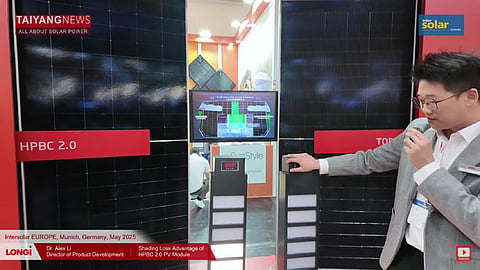

LONGi showcased its latest 670 W, 24.8% efficient Hi-MO 9 HPBC 2.0 module at the event
The HPBC 2.0 cell's improved Voc and Isc result from hybrid passivation, high-aspect ratio fingers, and 0BB technology
Unlike standard modules, the HPBC 2.0 cell avoids shutting down entire substrings during partial shading by bypassing individual shaded cells
LONGi Green Energy Technology Co., Ltd., a vertically integrated Chinese PV company active across the wafer, cell, and module value chain, is undergoing an accelerated transition toward a product lineup based on back-contact (BC) cell technology. Targeting the European PV market, the company's booth showcased a wide range of its latest product lineup at the recently held Intersolar Europe 2025. Alex Li, Director of Product Development at LONGi Solar, presented the company’s latest Hi-MO 9 series BC module and offered insights into the advancements of its HPBC technology to the TaiyangNews team. He also explained a live comparative demonstration between HPBC technology and its TOPCon counterpart, which was showcased during the event.
Cell Level Advancements
The back-contact (BC) cell architecture eliminates all front-side metallization by relocating both positive and negative contacts to the rear of the solar cell. This design maximizes light absorption on the front surface, improving efficiency while also enhancing the module’s aesthetic appeal.
Illustrating the value of LONGi’s HPBC technology, Dr. Alex Li stated, “we are able to untangle the optical and electrical impossible triangle during the past two decades of our conventional solar cell development,” referring to the successful integration of multiple technological innovations. LONGi uses hybrid passivation to increase the Voc, while the fingers with a high aspect ratio contribute to the improvement in the Isc and the bifacial factor. Furthermore, the implementation of busbarless (0BB) metallization technology has boosted the cell’s fill factor (FF), Li explained. All of this collectively helps to boost the efficiency, resulting in approximately 30 W more power at the module level compared to conventional designs and technologies.
Module Level Advancements The showcased Hi-MO 9 module delivers a labelled power output of 670 W and an efficiency of 24.80%—approximately 30 W higher than TOPCon modules of similar configuration, according to Li. He added that this power gain leads to reduced cost of balance-of-system (BoS), including trackers, DC cabling, combiner boxes, and civil works, thereby enabling a “substantially” reduced levelized cost of electricity (LCOE). A long-standing limitation of back-contact (BC) technology, its low bifaciality, stemmed from the relocation of both front and rear contacts over the cell’s rear side, has now been effectively addressed. Fueled by the cell level technological advancements, like fingers with high aspect ratio, the new module achieves a bifaciality factor between 75% and 80%, making it viable for utility-scale applications as well. “Five years ago, it was only used in rooftop projects because people believed that back-contact had absolutely zero scope for bifaciality,” Li noted. Today, the company boasts over 60 GW of BC module production capacity.
Better shading performance
LONGi also showcase a live demonstration comparing HPBC 2.0 with conventional TOPCon technology, illustrating how module output power varies in portrait orientation under partial shading conditions. As shading progresses across the module’s busbar line, simulated using an artificial cover, the HPBC 2.0 module continues generating power even when all substrings are partially shaded. In contrast, the TOPCon module’s performance declines more sharply.
Unlike conventional TOPCon half-cut cell modules, LONGi’s Hi-MO 9 module prevents an entire substring from shutting down by bypassing only the individually shaded cells. According to Li, this feature contributes to increased energy yield over the module’s 30-year service life.
To support the unique characteristics of BC cell architecture, LONGi’s HPBC module is constructed with a bill of materials (BOM) sourced from qualified suppliers. For instance, Li noted that the encapsulant used must offer enhanced resistance to moisture ingress to ensure long-term reliability.
